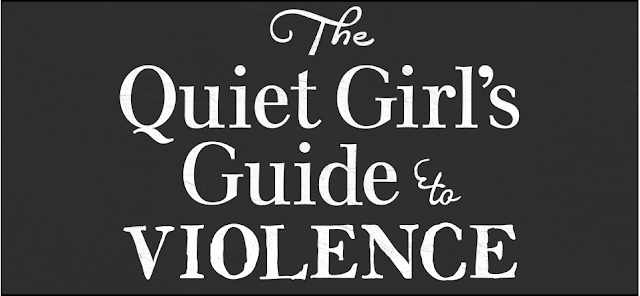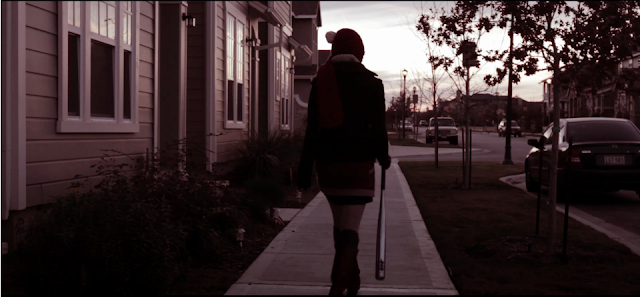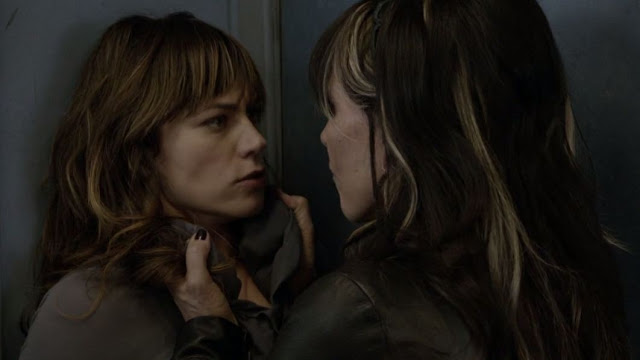“I have made a resolution. … People should not be allowed to get away with things.”
 |
| The Quiet Girls’ Guide to Violence poster |
Actually creating matter by naming it might be the prerogative of the gods, but there’s a certain generative power in naming even the most mundane things. When something is named, it gets a categorization, a way for us to conceptualize and talk about it as we couldn’t before.
If the protagonist of Rafael Antonio Ruiz’s short film The Quiet Girl’s Guide to Violence can be considered a Manic Pixie Dream Girl, then she’s certainly my favorite example of the trope.
Holly (Jennymarie Jemison) wears a hideous Christmas turtleneck, a cardigan, a bow-shaped barrette, and thick-rimmed glasses. She’s a librarian and a barista, two quintessentially MPDG occupations. She speaks without using contractions and expresses an awkward naivety in her interactions. In a different movie, she would be a perfect storm of quirk, but both the superb acting and the stylish direction make it quite clear from the get-go that we should not expect cloying indie-pop adorkableness.
Jemison plays Holly with a chilly, staring intensity whereby every frame of her face can be frozen to show only a soulful, sorrowful thoughtfulness, but in motion her seething desperation is palpable. Holly’s flashbacks to an incident of harassment are heralded by a rhythmic pounding noise, signaling that her titular quietness is certainly only surface-deep.
 |
| Jennymarie Jemison as Holly. |
The plot follows Holly’s revenge on two men who were responsible for a deeply scarring incident of harassment in her youth. Chance encounters with the men at her two places of employment spur flashbacks to the boys’ misogyny and sexual harassment, compelling her to take violent action.
Arguably, the film functions as a powerful feminist response to the MPDG trope. It is, of course, characteristic of the MPDG that she have neither agency nor personality of her own, existing solely as a corollary to the male main character. Holly upends that completely: She is a woman whose quiet, unthreatening quirkiness has been molded by misogynistic male dominance of her world, but she explodes that dominance and the identity it is has forced upon her. In a nifty stylistic touch, Holly’s glasses have lenses only in the scenes where she perpetrates violence. She can only see clearly when meting out her brand of vigilante justice; in the daily grind of her life, she is trapped in a role as false as any hipster’s empty frames. “I am seeing the world again, for the first time in a long time,” she declares to her coworker, a performance artist heavily influenced by Karen Finley.
In fact, this same coworker offers a rather blistering commentary on MPDG/boy relations: “No, I don’t think he likes you. I think he has a morbid fascination with you because he’s a fucking idiot.” It’s harsh, and motivated by her jealousy of the guy’s interest in Holly, but it’s not an unfair assessment of the usual trajectory of such films (heck, Joseph Gordon-Levitt said as much about his character in 500 Days of Summer). Holly herself seems to realize this, stepping back from harming the other woman too much. In a patriarchal society, other women are not the enemy.
 |
| Holly with a bat |
My sympathizing with Holly is not a matter of condoning her violence, but of understanding its roots. A frightened Jeff can hardly believe that Holly is still so profoundly affected by one incident from years before, but he is overlooking the context. What seems to him an isolated instance of an awkward kid lashing out at a girl because he doesn’t know how to tell her he likes her is, to anyone with experience of being read as female in our society, the beginning of a lifetime of harassment and threats and abuse, a collective welter of misogyny that tries to force women to exist only in relation to male subjectivity. Beating men’s heads in is probably not a helpful real-world response, but it’s a cathartic fiction, and it is certainly not an unfathomable reaction to the pressures of being a woman in a sexist world.
The Quiet Girl’s Guide to Violence presents female rage with a nuance and sympathy rarely if ever seen in mainstream media. Holly’s actions are unsettling precisely because they are so understandable. It’s a brutal lesson, but one we men really need to learn: Women – even cute quirky MPDG-type women – do not exist for us.





